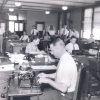calsfoundation@cals.org
The Liberator
The Liberator was an anti-Catholic weekly newspaper published in Magnolia (Columbia County) from 1912 to 1915. It is representative of a type of journalism that railed against Catholicism in the early 1900s and was particularly strong in the South and the Midwest. Populist politician Tom Watson of Georgia had launched a new wave of anti-Catholic journalism in 1910 with his Watson’s Jeffersonian Magazine, but the largest anti-Catholic paper was The Menace, published in Aurora, in the Missouri Ozarks, approximately forty miles north of the Arkansas line. Founded in 1911, The Menace had 1.5 million subscriptions by 1915, making it one of the most widely circulated publications in the country. The Liberator was a smaller regional paper, similar to other anti-Catholic newspapers in Iola, Kansas; Milan, Illinois; Wilkesboro, North Carolina; and Silverton, Oregon.
The Reverend Joseph A. Scarboro, a Missionary Baptist preacher, edited The Liberator with assistance from his son, Joseph Scarboro Jr. Born in Georgia in 1857, Scarboro was largely self-educated. He moved to Arkansas to become pastor of First Baptist Church in Magnolia in 1909, shortly after the Missionary Baptist movement seceded from the Southern Baptist Convention. In the following year, Scarboro began publishing a monthly magazine titled The Plain Truth. In March 1912, he converted this publication into the weekly Liberator and devoted its contents exclusively to the anti-Catholic crusade. Only two issues of the newspaper, for October 2 and 16, 1913, are known to be extant; they can be found at the Arkansas State Archives in Little Rock (Pulaski County). On its first page, the paper listed its twelve principles, one that demanded that Catholics not be allowed to vote or hold public office and another that called for government officials to inspect convents and punish anyone keeping nuns there as sexual slaves.
In 1913, Scarboro gave up pastoral duties to devote his time exclusively to his anti-Catholic work. Besides editing The Liberator, he lectured widely against Catholicism and lobbied for political measures, such as Convent Inspection legislation, first introduced in the Arkansas General Assembly in 1913 and passed into law in 1915.
At its peak, The Liberator claimed to have 15,000 subscriptions at an annual cost per subscription of fifty cents. But Scarboro was always desperate for funds. By 1913, he was trying to sell stock in the paper for five dollars a share. In the next year, he was begging readers of the Little Rock Missionary Baptist weekly, The Baptist, to help him get 10,000 new subscriptions. In August 1914, he asked residents of Mena (Polk County) to advance $6,000 in exchange for moving the paper to that town, charging that the town’s newspaper, The Mena Star, was biased in favor of Catholics. In 1915, Scarboro shut down The Liberator and returned to his native Georgia, saying he had lost every dollar he had “fighting Romanism.” Scarboro died in Georgia in 1932.
Anti-Catholic sentiments declined in the later 1910s, as the United States entered World War I. In the early 1920s, the movement, along with most of its rhetoric, was subsumed into the emerging Ku Klux Klan.
For additional information:
Barnes, Kenneth C. Anti-Catholicism in Arkansas: How Politicians, the Press, the Klan, and Religious Leaders Imagined an Enemy, 1910–1960. Fayetteville: University of Arkansas Press, 2016.
Nordstrom, Justin. Danger on the Doorstep: Anti-Catholicism and American Print Culture in the Progressive Era. Notre Dame, IN: University of Notre Dame Press, 2006.
Kenneth C. Barnes
University of Central Arkansas
 Early Twentieth Century, 1901 through 1940
Early Twentieth Century, 1901 through 1940 Mass Media
Mass Media Joseph A. Scarboro
Joseph A. Scarboro 




Comments
No comments on this entry yet.